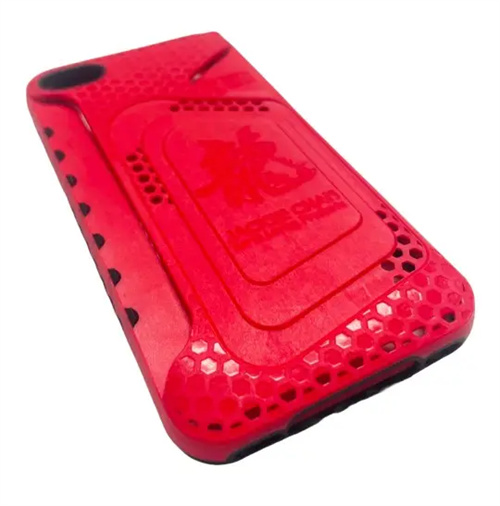Injection water hole center position and cavity pressure
As a core component of the mold cooling system, the design of the injection molding water hole’s center position directly influences the mold temperature distribution, which in turn has a significant impact on the cavity pressure. The water hole center position refers to the distance between the water hole axis and the cavity surface. This parameter determines cooling efficiency and temperature uniformity. When the water hole center is too far away, the cooling rate is slow, the cavity surface temperature is high, and the melt shrinks slowly during cooling, resulting in higher pressure required to replenish the melt during the holding phase. On the other hand, if the water hole is too close, the cooling rate is too rapid, and the melt solidifies prematurely at the cavity edge, increasing flow resistance and increasing cavity pressure loss. For example, when an automotive parts factory was producing PA66 gears, the water hole center position was 15mm from the cavity surface. Inadequate cooling caused the cavity pressure to be 20% higher than the standard value, increasing energy consumption and causing flash defects on the gears.

The center position of the water hole indirectly affects the fluidity of the melt, indirectly altering the cavity pressure. Proper water hole placement maintains the cavity temperature within the optimal range (typically 10-20°C above the material’s glass transition temperature), ensuring good melt fluidity, reducing flow resistance, and achieving uniform cavity pressure distribution. When water hole positioning deviates, resulting in localized overtemperature, the melt becomes too fluid, easily accumulating in the corners of the cavity, creating localized high pressure. Meanwhile, areas with low temperatures experience premature solidification, creating low-pressure zones and uneven pressure distribution. In the case of a PC laptop casing produced by an electronics factory, the water hole on one side was too close (only 5mm from the cavity surface). This area exhibited low temperatures, hindering melt flow and causing cavity pressure to be 15% lower than the other side, resulting in a difference in wall thickness between the two sides of the casing. Adjusting the water hole position to 8mm further evened out the cavity temperature and reduced the pressure difference to less than 3%.

The uniformity of the distribution of the center positions of water holes is crucial to the stability of the cavity pressure. When the center positions of multiple water holes are inconsistent, the cooling rates of different areas of the mold will be different, resulting in differences in the solidification time of the melt in the cavity, which in turn causes lags or fluctuations in pressure transmission. For example, in the mold of a large plastic part, if the edge water holes are located far away and the center water holes are located close, the edge melt will cool slowly and the center will cool quickly. During pressure holding, the edge requires continuous high pressure, while the center pressure drops rapidly, forming a pressure gradient. When an electric appliance factory produced a washing machine shell made of ABS material, the cavity pressure fluctuated by 10% due to the uneven distribution of water holes, resulting in obvious shrinkage marks and weld marks on the shell surface. By unifying the center position of the water holes (all set to 10mm), the pressure fluctuation was reduced to 3%, and the defect rate was reduced by 60%.

The matching relationship between the center position of the water hole and the cavity pressure needs to be adjusted according to the plastic part material and structure. For high-viscosity materials (such as PC and PMMA), the center distance of the water holes needs to be appropriately reduced (usually 8-12mm) to accelerate cooling to control the melt flow range, but it is necessary to avoid excessive cooling that causes a sudden pressure increase. For low-viscosity materials (such as PE and PP), the water hole distance can be increased (12-15mm) to prevent excessive cooling and increased flow resistance. For thin-walled plastic parts, the water holes should be positioned closer (6-10mm) to ensure rapid cooling to maintain cavity pressure. Thick-walled plastic parts require water holes that are slightly farther away (15-20mm) to avoid premature surface solidification that affects internal pressure transmission. When a pipe factory produced thick-walled PE pipes, it adjusted the center position of the water holes from 12mm to 18mm, which extended the cavity pressure maintenance time by 2 seconds and effectively reduced shrinkage defects inside the pipe.

Practical methods for optimizing the center position of water holes to regulate cavity pressure include: using CAE simulation software to analyze the temperature and pressure distribution at different water hole locations to determine the optimal positioning parameters; employing conformal cooling to maintain a constant distance between the center of the water hole and the cavity surface, particularly for complex curved plastic parts; and regularly checking the actual position of the water holes (via mold CT scanning) to ensure consistency with the design and avoid pressure anomalies caused by machining errors. A precision mold manufacturer introduced a mold temperature-pressure collaborative simulation system. Based on the simulation results, the optimized water hole center position improved cavity pressure stability by 40% and part dimensional accuracy by one level. Furthermore, the cooling water flow rate and temperature must be combined to ensure that the cooling effect of the water holes matches the cavity pressure requirements, creating a dynamic balance.
